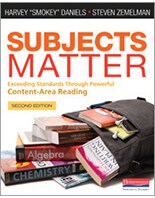
Imprint
Heinemann
Author(s)
Harvey Daniels
Subjects Matter, Second Edition: Exceeding Standards Through Powerful Content-Area Reading

Imprint
Heinemann
Author(s)
Harvey Daniels
“To help every kid fall in love with at least one field of knowledge, our students must encounter our fields’ most galvanizing, tantalizing, and pivotal documents. This book is about making those encounters as compelling as we can make them.”
—Harvey “Smokey” Daniels and Steven Zemelman
We are specialists to the bone—in science, math, social studies, art, music, business, and foreign language. But now, new standards require us to help our students better understand the distinctive texts in our subject areas. “Nobody’s making us into reading teachers,” write Smokey Daniels and Steve Zemelman, “but we must become teachers of disciplinary thinking through our students’ reading.”
If this shift sounds like a tough one, Subjects Matter, Second Edition is your solution. Smokey and Steve, share exactly what you need to help students read your nonfiction content closely and strategically:
Subjects Matter, Second Edition enables deep, thoughtful learning for your students, while keeping the irreverent, inspiring heart that’s made the first edition indispensable. You’ll discover fresh and re-energized lessons, completely updated research, and vibrant vignettes from new colleagues and old friends who have as much passion for their subjects as you do.
“We’ll be using methods particular to our fields as well as engaging reading materials that help students understand and remember our content better,” write Smokey and Steve. “We can realize that vision of the light going on in kids’ heads and maybe fill them with enthusiasm about the amazing subject matter that we have to offer. Sound good? Let’s get to work.”
1. The Core Purposes of Reading
2. How Smart Readers Think
3. Why Textbooks Are Not Enough
4. Toward a Balanced Diet of Reading
5. Tools for Thinking: Reading Strategies Across the Curriculum
LESSONS
6. How to Use a Textbook
7. Building a Community of Learners
8. Independent Reading Workshop in Content Areas
9. Content-Area Book Clubs
10. Inquiry Units
11. Help for Struggling Readers
12. Recommendations from Reading Research
